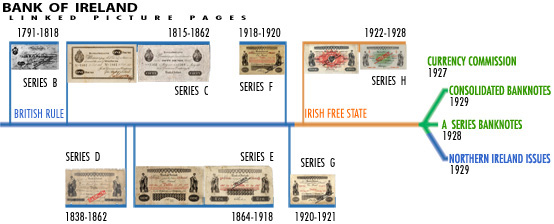
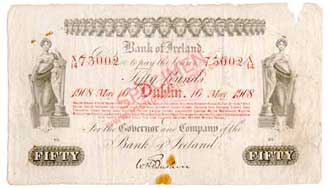
Bank of Ireland, Eight Series: Series A 1783 - Series B 1791 - Series C 1815 - Series D 1838 - Series E 1864 - Series F 1918 - Series G 1920 - Series H 1922
Series I, J, K Northern Ireland Issue, commencing 1929
The Bank of Ireland was established by Royal Charter on 10 May 1783 as a private joint stock bank, by a group of over 200 Irish businessmen, land owners and clergymen, to stimulate and regulate the Irish economy and to provide it with a stable banknote currency. The bank was granted the sole right of banknote issue in Ireland except for Private banks of six partners or less, and was to be banker to the government.
Bank of Ireland commenced business on 25 June 1783, and proceeded to issue banknotes for circulation throughout the country. It was the first bank in Ireland that issued notes for use throughout the country. The bank was essentially similar to a modern Central Bank of sorts, and was founded along the lines of The Bank of England and The Bank of Scotland.
The Bank of Ireland’s first premises was in Mary’s Abbey, Dublin, purchased in 1784. In 1802 the bank purchased the old Irish Parliament House, College Green, Dublin, vacant since the Act of Union, 1801, and located its head office there in 1808. One of the most attractive buildings in the city of Dublin, the former parliament House has been the bank’s flagship branch ever since and was its head office for over a century.
Bank of Ireland was the largest issuer of banknotes before partition in 1922 and issued a wide range of denominations. The highest known denomination of a Bank of Ireland note is £500, a note dated 18 Dec 1869, Series E Type B. Other Irish banks issued notes up to £100 in value prior to partition.
The partition of Ireland in 1921 lead the the partition of Irish currency in 1929 into the Northern Ireland Issue and the Currency Commission issues in the Irish Free State. The highest denomination notes issued in each of the new jurisdictions was £100.
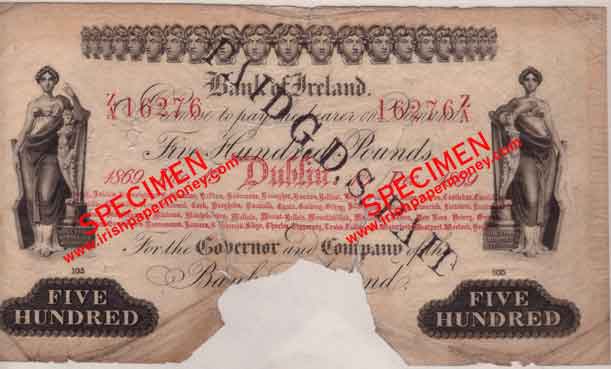
The creation of Joint Stock banks of note issue, with rights to issue banknotes outside of a 50 mile radius of Dublin as a result of the 1824 Act, and the subsequent erosion of the Bank of Ireland’s special privileges, leading up to their abolition with the 1845 Irish Banking Act, provided for the effective reduction in status of the Bank of Ireland to that of a Joint Stock bank.
It was as a result of this levelling of the rules that the bank felt it necessary to expand into the country and compete with the other banks by establishing its own branches, the first of which was opened in March 1825, in Cork. Prior to the 1824 Act, the Bank of Ireland had largely ignored the country outside of Dublin. The bank, however, still had significance in that its assets and prestige far exceeded that of any other bank, and its notes were considered to be as good as gold.
With Irish independence in 1921, the Bank of Ireland aspired to become the currency regulatory authority for the new Irish Free State, even though its ethos at the time would not have favoured Irish independence. Although it failed in these aspirations, the bank served as an important part of the Currency Commission’s currency distribution network.
In a move which lead on to a general modernisation of Irish currency notes of all the banks, Bank of Ireland was the first bank to reduce the size of its notes when it produced a reduced size £1 note dated March 1918. Other denominations reamined large size. Branches were removed from the reduced size £1 notes in 1921.
In 1922 Bank of Ireland produced an entirely new design, printed on both sides, with denominations up to £100 issued. £1, £5, £10 have been seen in issued form. It is likely that £20, £50, and £100 notes were never issued.
The Bank of Ireland issued notes under the Consolidated Banknote system from 1929 to 1939, as well as its own Bank of Ireland Northern Ireland issue. The Bank of Ireland exists to the present day,and continues to issue banknotes in Northern Ireland. The bank took over both the Hibernian Bank and the National Bank.
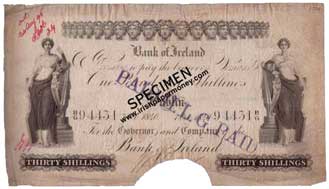
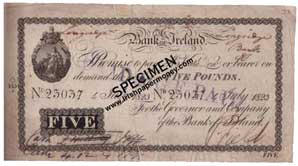
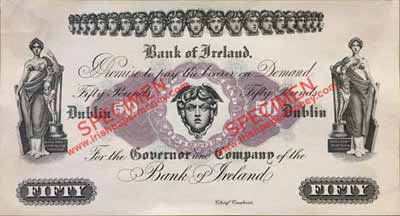
Irish Joint Stock Banks of Note Issue from 1783
Contemporary Forgeries of Early Irish Banknotes ca1800-1930
Irish Three Pound Notes of the Joint Stock Banks
The Transition of Irish Currency, Irish banknotes 1918–1928
The Partition of Irish currency, Irish banknotes 1928–1930